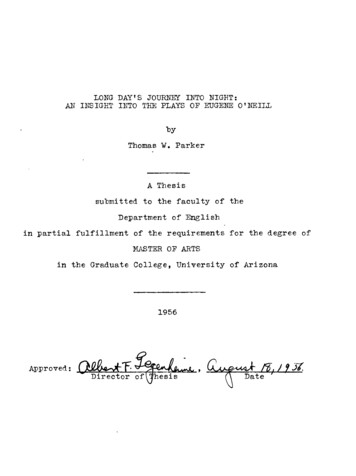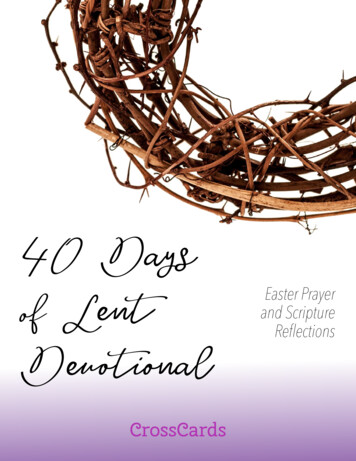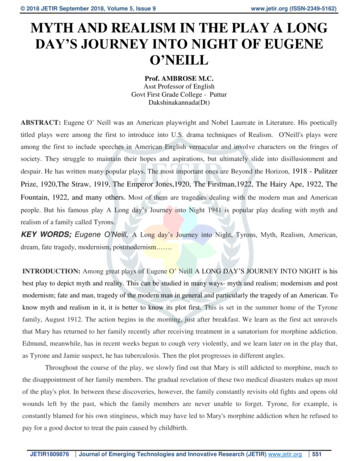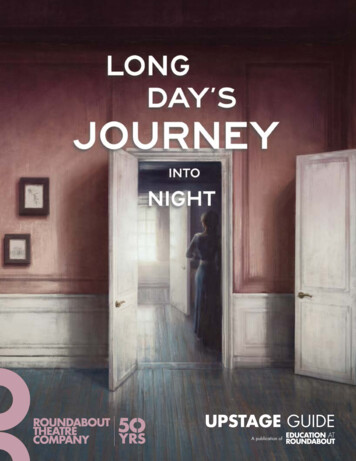
Transcription
LONG DAY'S JOURNEY INTO NIGHT:AN INSIGHT INTO THE PLAYS OF EUGENE O'NEILL byThomas W. ParkerA Thesissubmitted to the faculty of theDepartment of Englishin partial fulfillment of the requirements for the degree ofMASTER OF ARTSin the Graduate College, University of Arizona1956Ft , J 9Approved:Director ofWhesisDate
dRV
f 979// 9 6'S3This thesis has "been submitted in partial fulfillmentof requirements for an advanced degree at the Universityof Arizona and is deposited in the Library to be made available to borrowers under rules of the Library.Brief quota tions from this thesis are allowable without special per mission, provided that accurate acknowledgment of sourceis made. Requests for permission for extended quotationfrom or reproduction of this manuscript in whole or inpart may be granted by the head of the major departmentor the dean of the Graduate College when in their judg ment the proposed use of the material is in the interestsof scholarship. In all other instances, however, permis sion must be obtained from the author.
COHTEETSI. IETR0DU0T10E. . . . . . . .II. LOEG DAYS JOTJRHEY IETO EIGHT .III. AUTOBIOGRAPHICAL THEMES.1. .IV. BEYOED THE HORIZOE . . . . . .Vo DESIRE UHDER THE ELMSVI. MARCO MILLIOES. . . . . .VII. THE GREAT GOD B R O W .VIII. COECLUSIOE.‘ . . .6. 26. 33. 40. 45. » . 53. . . 65
INTRODUCTIONIn a letter to Barrett Clark3 in 19269 Eugene O’Neillwrote that someday, if he could "muster the requisite inter est-- and nerve.*;-simultaneously ,11family background he might write about his"The truth," said O ’Neill, "would makesuch a much more interesting— and incredible! — legend." *Thirty years later, in February, 1956, long Day’sJourney Into Night was published posthumouslys The playmay have been what O’Neill envisioned, for it is not onlyhis most autobiographical work5it is also incredibly tragic.It is obviously an attempt on the. part of the dramatist tolook into his own past and to record faithfully, but sym pathetically, what he recalled. Although there have beenother highly personal, semi-autobiographical plays ofO’Neill, none of them-'have adhered as closely to knownbiographical data as Long Day’s Journey»At its premiere in Stockholm, Sweden, O’Neill’s lastplay proved itself to be more than just a dramatic memoir,however„ According to its. reviews, it seems to have survived1 Quoted in Barrett Clark, Eugene O ’Neill: The Manand His Plays, rev. ed», (New York, 1936), p. 9.
the test of performance*The play is reported to have"been ""gripping and moving theater" despite its preponder ance of dialogue and lack of action»2The enthusiasticStockholm audience was held in suspense throughout thelong evening»But the most interesting aspect of Long Bay"s Journeyis its painfully autobiographical nature*the play takes place when0The action of"heillg as a young man of twenty-four, was confronted "by a succession of personal and familycrises His health had become critical, his career wasreaching a turning point, and his family had long beensuffering almost unbearable anguish resulting from sensesof guilt and frustration.That these early years, as re vealed by Long Bay"s Journey profoundly affected O ’Heill’s0personality and later dramatic works becomes increasinglyobvious as one studies this autobiographical play.It isclear that sources of some of his most recurrent themeslie here in his own "Long Bay"s Journey,".A biographical approach to literature has not alwaysenjoyed the highest repute among scholars.It has some times been criticized as being unseholarly, or at bestinconsequential.Admittedly, the criticism is not alwaysStephen- Whicker, "O"Belli s Long Journey," Commonweal,LXIII (Harch 16, 1956), 614,--- 88
unjmstified»Scholarship.which “proves9 11for instancethat Shakespeare1s references to the sea inevitably re sult ed from long years of nautical life is somewhat ten uous*Shakespeare was an amazingly objective dramatist;and even if more were known about his life; it might bedifficult to discover any ostensible relationship betweenit and his plays.In his objectivity Shakespeare was a notable excep tion; howeverPew if any writers cam completely divorce9their art from their personal lives*They vary of course;9in their degree of subjectivity; but usually they find; atleast subconsciouslyg certain sources of inspiration intheir own past*The study of a writer’s biography; there fore; will often broaden a reader’s understanding andappreciation for his works * To cite only one example; isnot our appreciation for In Memorlam heightened because weknow it represents the feelings of the poet after thedeath of a close friend?Barrett Clark has suggested that “An intelligiblediscussion of ’Me ill* s plays must be based on some0knowledge of their origin during the years whens howeverunconsciously; he was groping for a meaning in life****"There can be little doubt that O’Ueill has always been3 Barrett Clark; pp* 5-6*3
a highly subjective writer, In fact, one aspect ahout whichmost critics agree is this element of subjectivity.Through out his plays, from Beyond the Horizon to Long Day*s Journey,there has appeared a typical O’Heill hero--sensitive, poetic,and unhappy. The inner struggles of this protagonist--his doubts, his longing for certainty, his knowledge of thedream* s appeal--have long been suspected as being projec tions of O’Eeill’s own thoughts. Unfortunately, however, the biography of0*kTeill hasnot yet been written. Barrett Clark* s work is extremelyhelpful in outlining the bare facts of the playwright *syouth, but it does not presume to be truly biographical.Thus, g*Heill*s boyhood and family background have remaineda kind of mystery.ure of01Critics have sensed the personal nat Heill* s writing, but there has been little bio graphical information to support the impression With the publication of Long Day*s Journey some ofthis mystery has been dissolved This autobiographicalwork sheds a great deal of light upon the mind of the drama tist and his early family life.Because of O’Ifeill* s sub jectivity, it also'provides a startling insight intomany of his earlier plays.It explains the recurrence4 Several writers have made this point. Among themare Martin Lamm, Modern Drama,(Hew York, 1955), p 517 §Elizabeth Shepley Sergeant, Eire Under the Andes, (HewYork, 19S7), pp. 81-8%; and Sophus Keith Winther, EugeneO’fleills A Critical Study,, (hew York, 1954), p. 42 ,
of such themes as the father-sob antagonisms, the devotionof the son for his mother and the problem of the ereative9artist in a materialistic environment« This is not to saythat hong Day*s Journey excludes other sources for thesethemesoficatioBoObviously such a statement would be an over-simpliIt is clear nevertheless, that O ’Eeill* s family9did leave its indelible mark upon his thinking«,In the succeeding chapters of this thesis it willfirst be shown that Long Day*a Journey Into Eight isclearly an autobiographical work.Once this is established,several of O ’Neill* s most representative plays will bestudied in an effort to demonstrate the autobiographicalnature of some of his most recurrent themese
XXLOHG- DAY’S JOUEHEY 133Tb Bia-HTEmgene O ’Heill’s last play Is a powerful psyehologir ''pal study of an American family. Like most other families,this one is hound together hy an inherent love, though itis more often felt than expressed.What is unique, andtragic, about the Tyrone family is that this binding forcehas for years been threatened by deep resentments, long-,standing jealousies, and thwarted dreams. . The play is notthe simple depiction of a family’s disintegration; somehowthe reader knows the Tyrones will endure. Bather it is\the tragedy of misunderstanding, of estrangement, andisolation.The protagonist of the play is probably Edmund, theyounger son.However, the reader sympathizes with eachmember of the family, perhaps especially with the mother,Mary Tyrone'. We learn early in the play that Mary hasreturned only.two months before from a sanatorium whereshe was seemingly" cured of a dope addiction.Althoughthings have gone well for a time, she has become increas ingly concerned about the health of her sonlEdmund.Shetries to convince herself that what is probably tubercu losis, which he has contracted after several years ofgenerally unhealthy living, is only a "summer cold."can not help remembering, too, that her father died ofShe
consumption years earlier0In the meantime the reader "begins to understand someof the reasons "behind Mary* s weakness for drugs*Thefather James Tyrone is a well-known and beloved actor9who for years has been touring the country acting the leadrole in a successful romantic drama*This one play hasassured him of thirty-five to forty thousand dollars aseason*But because of his poverty-stricken youth9firston a farm in Ireland and later as a young immigrant inthis country; he can not free himself from a frugalitywhich is deeply ingrained* In a sense this frugality has9been the undoing of the entire family*. Fever providingthem with a permanent home, he has always housed his wifeand children in cheap hotels while on tours and taken themin the summertime to this shabby; poorly-furnished FewEngland house*It is revealed that his wife's addictionbegan just after her son Edmund was born, when a quackhotel doctor administered an overdose of morphine to killher pain*Fow, each time James Tyrone sends his wifeaway for a ,!Stire9 18it .is always to the cheapest sanatoriumfor the shortest time possible*Still; reprehensiblethough he is Tyrone is a sympathetic and remarkably well9drawn character*As this hectic summer day9in August of 1912; progressesit becomes painfully obvious to each member of the familythat Mary has already begun to indulge in her only form of9
escape6The older son Jamie a confirmed cynic who sees9only the "worst motives "behind everything9" is the firstto detect his mother8s relapse*He is thirty-threeg al most ten years elder than Edmund*, and is aging, prematurely"because of habitual dissipation*"When his younger brotherwas coming of age Jamie taught him that getting drunk9was romantic and that whores were "fascinating vampires*"His present-attitude toward Edmund is a mixture of deepseated jealousy and sincere affection* He can not helpremembering that had his younger brother never been bornhis mother might never have become a dope addict*Heis also jealous of Edmund8s ability to write poetry andfor his success as a small-town newspaper reporter*.Toward the end of the play when he .is more inebriated9than usual9he warns him that he will always try. to makea bum of him so that he will not succeed*HoweverJamieis genuinely distressed by his brother’s health, and itis difficult to determine which is his stronger motive,jealousy or fondness* Two members of the Tyrone family who clearly havelittle affection for each other are Jamie and his father*Tyrone regards his son as a good-for-nothing bum who hasnever "learned the value of a dollar9" while Jamie.con siders his father the "tight-wad" responsible for allthe ills of the family*
Ob "felie other hand the feelings of the rest of thefamily toward Mary Tyrone are those of devotion and sym pathy» The seene in which Tyrone and his sons gradually"become aware that she has once again given in to her weak ness is poignantly tragic« Each tries not to "believeWhat he secretly knows is really true*But finally each"becomes resigned to the hopelessness of Mary s plight .1By the time Edmund1s ”summer cold" is diagnosed asconsumption "by the family doctor s Mary has "become almostlost in her dreams of her early convent days "before shemet her husband Jamie resorts to his habitual debauch eries at the local whorehouse This leaves Edmund andhis father for perhaps the most revealing scene of theplay It. is here that Tyrone admits to his son that hisconcern for the "value of the dollar" actually ruinedhis career Eeeling that he could not afford to giveup his lucrative roles he became a slave to it and there by lost his chance to become a great actor He also admitsthat because of his frugality he has allowed the familydoctor to talk him into sending Edmund to the state farmfor tuberculars Edmund reacts by saying that although9he can5 1help liking his father "in spite of everythingP"he has every reason to despise him Mollified however9by the alcohol which flows freely throughout the play,Edmund philosophizes poetically about his recent years9
10away from homeHe recalls mystical experiences he has0had at sea, when perhaps as a lookout in the crow’s-nesthe could, for a moment, understand the "beauty and meaningin life. But immediately the fog would descend, and the"beauty would "be irrevocably lost.Finally, late at night Jamie returns on the last' trolley, and the three men set about to absolve them selves in alcohol until Mary stops roaming around upstairsand goes to bed.But Mary descends in a dream world ofher own, and they are unfortunately shocked into sobriety.She reminisces about her happy girlhood days in, the con-' .vent. What was it that happened in the spring of her senior year?Oh yes, she remembers.”1 fell in lovewith James Tyrone and was so happy for a time. 11 Like so many other O’Ueill plays the theme, of psycho logical determinism pervades this last autobiographicalwork.Life has made the Tyrones what they are, andeach of them is powerless in his effort to changewhat must be.It is as Mary says.the things life has done to us."Hone of us can helpThey’re done before1 Eugene O ’Heill, Long Day’s Journey into Eight,(Hew Haven, 1956), p. 176.
11you realize it, and once they're done they make you doother things until at last everything comes between youand what you'd like to he, and you've lost your true selfforevero" Again after Edmund curses his brother forone of his outbursts of cynicism, Mary expresses thismood philosophically„"It’s wrong to blame your brother*He can't help being what the past has made him*more than your father can.Or you*AnyOr I." 3 Edmund'sfather must always be frugal; it is-his past, and the pastis the tragedy of this family.In their efforts to escape the past Mary resorts tostronger doses of morphine, her husband and sons to moreand more alcohol * The symbolic expression of this desireto escape is fog, a symbol.which O'Eeill has used in sev eral earlier plays, When hong hay's Journey begins,the fog has recently lifted.The atmosphere remainsclear throughout the first act, but at the beginning ofAct II it has become sultry, and by Act III the. fog hasrolled in and engulfed the Tyrones' summer home.Theaudience is constantly reminded of its presence duringthe last two acts by the intermittent moaning of a fog horn off-stage While the family at first dreads the2 II, i, p. 61*3 II, i, p. 64.4 Bound East for Cardiff, ffog, and Anna Christie
12fog’s approaehg it becomes a source of escape for themonce its presence is inevitable,,world and the world from you0"It hides you from theYou feel that everythinghas changed and nothing is what it seemed to be 9Hoone can find or touch you any more,,"Another conspicuous element in Long Day’s Journeyis the duality of the characters« Each member of theTyrone family has two personalities, one that accusesand one that apologizeso. for example, in Act III Edmundblurts out condemningly to his mother,It’s pretty hard to take at times having a dopefiend for a motherIShe winces--all life seeming to drain from herface leaving it with the appearance of a plastercast. Instantly Edmund wishes he could takeback what.he has said* He stammers miserablyForgive me. Mama I was angry You hurt me There is a pause in which the foghorn and theships’ bells are heard 990Much of the emotional tension of hong Day’s Journey isachieved by this dual nature of each character Inearlier works this theme necessitated the use of masks,asides, or even two characters Its treatment in hongDay’s Journey is O’Heill’s most successful, in my opinion Pessimistic though this last play certainly is, itis not completely black While it is deeply tragic, itstill leaves the reader something to cling to 5 III, p 98 61 1 1, p 120.Eveni.v.
13as late as 1941, when O’leill was suffering from his"life-sickness, 11he was reaffirming his faith in loveas an enduring force Mary Tyrone clings to this faithherselfoIn Act II, Scene ii, she says impulsively toher hushand, "We've loved each otherJWe always willJLet’s remember only that, and not try to understand whatwe cannot understand, or help things that cannot behelped--the things life has done to us we cannot excuseor explaino” Though somewhat more obscured, the themeof The Straw, of Lazarus Laughed, and of Ah Wilderness !is still present here in Long Day’s Journey„To the reader who is acquainted with O ’ETeill’s otherplays and who knows something of the dramatist’s life itmust be apparent that Long Day’s Journey Into Eight con tains at least certain autobiographical elements»To myknowledge, no review of the play has failed to mentionthis pointeThe similarities between the Tyrones andwhat is known about Eugene O’Seill’s family are too num erous to be attributed to coincidenceeActually, there seems to be sufficient evidence tosupport the belief that the play is autobiographicallyaccurate in almost every detail0While it would be di gressive to examine all such evidence, the assumption7 p085
14that the play is autobiographical is a requisite to thepurpose of this thesis0Therefore, it will he necessaryto examine some of the more convincing evidence, bothexternal and internal0To most good Irishmen, this writer has discovered,the name “O’Ueill" is practically synonymous with "Tyrone*"The reason for this fact may be found in the history ofthe O ’Heills,, This family traces its ancestry back inIrish history to a certain Eoghan, one of the fourteensons of a Fifth Century King Mall*Boghan’s principal ity was called "Tir-Boghan," meaning the "region of Boghano"Gradually this name became altered to "Tir-Owen"and finally "Tyrone*" For centuries the region was theterritory of the 0 Beilis*5in Borthem Ireland*Bow, of course, it is a countyIt is interesting to note that mostof the famous O’Beilis in Irish history held the title ofEarl of Tyrone* Eugene O ’Beill, as the son of a proudIrish-born American, was probably frequently reminded ofhis family history and certainly must have been aware ofthe close relationship between these two names*Had heused the name "O’Beill" instead of "Tyrone" he might havedetracted from the dramatic merits of the play, by over emphasizing its autobiographical nature.8Encyclopaedia Britannica# tChi.eag.Q 1955), XXII,9p* 656*9 There was an illustrious Irish-born Spanish soldierby the name of Arthur O’Beill de Tyrone (1736-1814)*
One of the most convincing pieces of evidence of theplay’s highly personal.nature is O’Eeill’s dedication toLong Day’s Journey» Because of its relevance, the dedica tion is quoted here in its entirety.Bor Oarlotta, on our.12th Wedding AnniversaryDearest: I give you,the original script of this playof old sorrow, written in tears and "blood. A sadlyinappropriate gift, it would seem, for a day cele brating happiness. .But you will understand. I meanit as a tribute to your love and tenderness whichgave" me the faith in love that enabled me to facemy dead at last and write this play— -write it withdeep pity and understanding and forgiveness forall the four haunted Tyrones. ,These twelve years, Beloved One, have been a Journeyinto Light--into love. You know my gratitude. Andw iow!—--- — —--------- - GEIETao HousetaJuly 22, 1941. 1 0The most significant phrase in this dedication note is "toface my dead."If O’Heill did not mean his own family andall of the sad memories associated with it, then its mean ing is a bit obscure.O ’Heill’s letter to Barrett Clarkin 1926, quoted from on page1, throws further light uponthis point . It indicates that O’Heill had been consideringwriting such an autobiographical work for many years; thushis saying that "at last" he was able to write about hisearly life becomes more meaningful.10 Eugene O ’Belli, Long Day’s Journey Into Eight,(Bew Haven, 1956) , p.
The stipulations O ’Belli placed upon the publicationand performance of Long Pay1s Journey likewise suggest itsautobiographical mature.It was his request that it beneither published nor performed until twenty five yearsafter his death.He also asked that the first perform ance be- in Sweden, a country which has long been receptiveto his plays.Although Mrs. 0’Belli complied with thislatter request (the play was-performed in Stockholm inFebruary, 1956), she evidently felt that by 1978 much ofthe play’s impact would be lost.Whether she was justi fied or not in her reasoning, admirers of O’Weill areundoubtedly grateful that they did not have to wait twentyfive years to read Long Day1s Journey. 0 Weill s reason11for the conditions, he imposed, especially upon the publi cation, must be that he considered the play highly personal.Similarities between Long Day1s Journey and otherplays of 0 Weill provide further autobiographical evidence.1It has already been noted in the introduction to thisthesis that many of. 0 Weill’s recurrent themes and situ 1ations can be traced to data revealed in Long Day1s Journey.Studies of these similarities will be made in succeeding.chapters.However, two matters of resemblance, one ofstage setting, the other of character-iiatiqE% ihbUiM be11 Harold Clurman, "The(March 5, 1956), p. 182. .01Weills, 11The Wat ion, GLXXXII
17mentioned at this point6Ah, Wilderness I9 O’Eeill’s only venture into domesticcomedy, was published in 1933 While its mood is'somewhatdifferent from hong Day1s Journey9it is considered bymost critics to be a mildly autobiographical play0O’Eeillhimself, in a conversation with Joseph KrutBh, stated that"he found his imagination haunted by the recollection ofa youthful experience, and he dramatized it in order.thata ghost might be laid *"Because Ah, Wilderness 1 by9the playwright1s admission, contains at least autobiograph ical elements, any similarities between it and hongDay1sJourney might conceivably furnish evidence of the autobio graphical nature of the latter play.With this in mind,it is interesting to note the striking resemblance, betweenthe two plays in the matter of stage settinga The sittingroom of the Miller home and the living room of the Tyrones1summer home are almost identical, according to CVHeill s1descriptions at the beginning, of both plays„ In fact, theonly significant, difference between the two rooms is thecontents of the bookshelves— the Millers811containingcheap sets," popular novels, and children's books andthe Tyrones Shakespeare, Karl Marx, Schopenhauer, etc.8Since for many years-Eugene O'leill's only home was his12 Joseph Wood Krutch, The American Drama Since 1918 sAn Informal History„(Kew York, 1 9 3 9 ) p 0 1150
18family s summer residence at Few London Connecticut§ it9seems reasonable to assume that it was this Few Londonhouse which O ’Feill recalled in both his plays In terms of its date of completion, O ’Heill’s lastplay was actually A Moon for the Misbegotten which was0written in 1943 and published in 19520 One of the socalled “misbegotten" characters in this play bears thesame name as Edmund Tyrone’s older brother, "James Ty roneQ“ From the standpoint of characterization and ofphysical description of both "Jamie s " it is obvious9tha,t O’Feill was writing about the same person*Bothdescriptions emphasize the signs of dissipation, the"Mephistophelian" quality, the cynical expression re lieved occasionally by a youthful charm*Each Tyronehas an aquiline nose and dark brown eyes * And each isdescribed as being the type which is popular with othermen and fascinating to women*However, though they areunmistakably the same person, the James Tyrone in A Moonfor the Misbegotten is treated somewhat more sympatheti cally than his counterpart in Long Lay s Journey* The9reason for this difference in treatment requires a reexamination of O’Feill’.s note to Carlotta, quoted ear lier 09Feill stated that through love he was enabledto face all of his family with "understanding and for giveness* " Yet, of all the Tyrones Jamie is clearly
19the least sympathetic character„ It may "be that O’Eeillwas aware of this and tried to do Jamie more justice inthe later play In A Moon for the Misbegotten James Ty rone is portrayed as a "basically charming, sensitive manwho "became a degenerate in spite of himself "While heis made no hero.g he is shown to be capable of tendernessand sincerity Had he married Josie Hogan a thoroughly9goodg amoral farm girl who loved him deeply he might9have redeemed himself However he is too far lost; as9the play.ends he is heading back to his Broadway lifeof "wine women and song.," and extinction 99.This leads to the consideration of some of thein ternal evidence of the autobiographical natureofLongDay*s Journey Again it should be noted that there isno biography of Eugene O ’Heill,life is extremely sketchy Information about hisBarrett Clark*s work David9Karsner’s Sixteen Authors to;One* %#and Elizabeth Ser geant’s Eire Under the Andes91-have been helpful butthey are far from being comprehensive in scope 9Thusit is possible to confirm only a small portion of thebiographical data revealed in Long Day*s Journey 13 (Hew York 1928)% pp 101-122 914 (Hew Yorks 1927)9 pp 81-104
20The little that is known about Eugene OtHeill’smother is that she was a quiet pious woman who spent9much of her girlhood in seelusion6One of her class mates at a Catholic convent in Cleveland was George Jeanhathan's mother.According to her, Ella Quinlanciwas re spected as being the most devout girl in the whole con vent, -L5 It was in Cleveland that Ella Quinlan met. JamesO'Eeiil, a gifted and popular actor.Because the kind ofsociety in which she was reared regarded actors as ir religious and also because O ’Heill was itinerant mostof the year, she found herself cut off from her familyand friends when she married this handsome actor,James O’Heill was born in Ireland in 1847, the sonof a small farm owner.When he was only five years old,he was brought to the United States where his familysettled in Buffalo, Hew York,After his father’s death,James, still a young boy, found himself required to con tribute to the family support.He worked for two yearsas a machinist but seems to have taken an early interestin the theater.In his teens he is known to have takenpart in a mob scene in one of Edwin Forrest’s plays, His gifts as an actor must have been considerable, for15 Barrett Clark, pp, 14-15,16 ’’Recalling the Romantic Drama,” The LiteraryDigests LX17I (Aug, 28, 1920), p, 29,
21later in his career Edwin Booth once said of him that heacted Othello "better than heP Booth, did, Incident ally, James Tyrone mentions Booth’s praise for his actingability to his son Edmund in Act IV of Bong Day s Journey8After their marriage, in July of 1895, the O’leillsspent the major portion of every year touring the country.Although Mrs, O’Beill always traveled with her husband,she never quite accepted his theatrical friends a's herequals,Eugene O’Eeill himself says that she "hadrather an aversion for the, ,Stage in general6, 112 Yetshe seems to have followed her husband faithfully and madeJames O’leill her one source of existence, 21.In 1882, at the Booth Theater in Few York, O ’leillfirst appeared as Edmond Dantes in The Count of MonteCristo, Before this event O’leill had been considereda versatile, up-and-coming actor, but because of thesmashing success of Monte Cristo, the public identifiedhim with this one role and wouldn’t permit him to playanything else.Occasionally, it seems, he tried to17 Barrett Clark, p, 15,18 p, 15019 Elizabeth Sergeant, p, 87,20 quoted in Barrett Clark, p, 16,21 Elizabeth Sergeant, p, 87,
atiandon the role for other parts.How.ever, these attemptswere relatively unsuccessful and he invariably returned9to his remunerative play. Eugene O1Heill speaks ofhis father’s career in Barrett Clark0l?My father wasreally a remarkable actor but the enormous success of9Monte Gristo kept him from doing other things.He couldgo out year after year and clear fifty thousand in aseason.He thought then he simply couldn’t afford todo anything else.bitter regrets.But in his later years he was full ofHe felt Monte Gristo had ruined his car eer as an artist.” 23Finally James O’Heill bought upthe sole title and all the rights to Monte Gristo. "Whenthe play was no longer appreciated in the legitimatetheater he took it in tabloid form to the vaudeville9stage and there it continued to be a financial success.Even during his last years while he was no longer activein the theater, he helped to make a movie of this infal lible drama.The O’Heills’ first-born was a son, James, about whomscarcely anything is known.Being reared in a theatricalenvironment, he is said to have worked at a stage.careerhimself, "as a line of least resistance." 2422 1HB, (Hew York, 1934) , XIV, pp. 43-44.23 Barrett Olark, p. 15.24 Karsner, p. 112.James was
23ten yearsrolder than Emgenes and when his younger "brotherwas in his teens James eonsidered it his moral obliga tion to teach him all that he had learned of the ways ofthe worldoAside from this hit of information* how ever * James’s influence upon the playwright can he onlysurmisedo'Compared'with the meager biographical data concern ing the rest of the family*our knowledge about EugeneO ’Ueill’s youth seems fairly complete» Although this isactually far from true*the outline of his boyhood andearly manhood is reasonably well-known.He was born onthe third floor of a cheap Hew York hotel* the BarrettHouse* on October 16* 1888»After spending his firstseven years touring the United States* while his fatherwas playing Edmond Dantes * he entered a Catholic board ing school in Hew York,Erom 1902 to 1906 he attendedthe Betts Academy at Stamfor
Thirty years later, in February, 1956, long Day's Journey Into Night was published posthumouslys The play may have been what O'Neill envisioned, for it is not only his most autobiographical work 5 it is also incredibly tragic. It is obviously an attempt on the. part of the dramatist to look into his own past and to record faithfully, but sym

![Welcome [dashdiet.me]](/img/17/30-day-weight-loss-journal.jpg)








